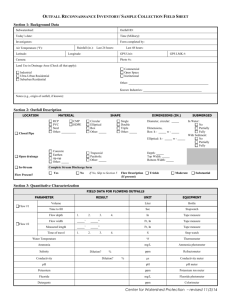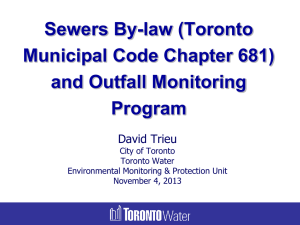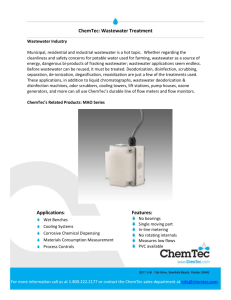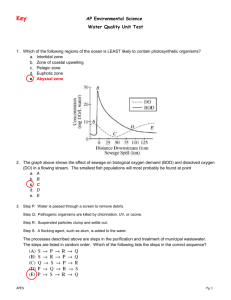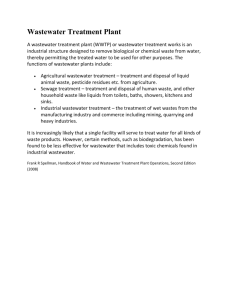What is the end product/result of this
advertisement
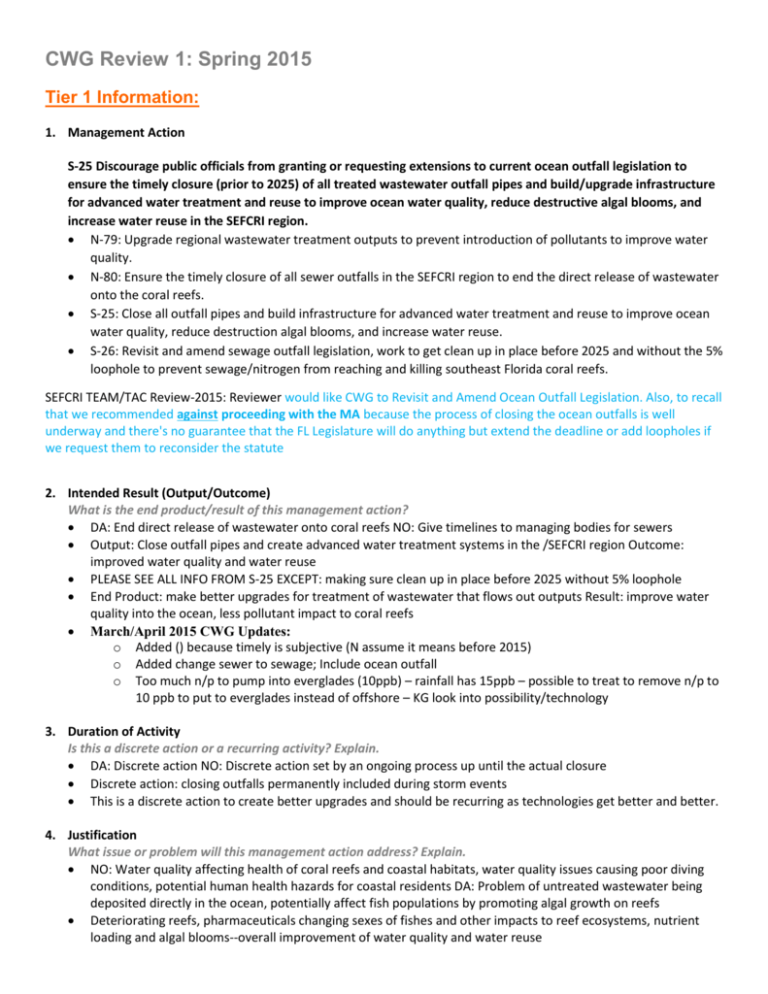
CWG Review 1: Spring 2015 Tier 1 Information: 1. Management Action S-25 Discourage public officials from granting or requesting extensions to current ocean outfall legislation to ensure the timely closure (prior to 2025) of all treated wastewater outfall pipes and build/upgrade infrastructure for advanced water treatment and reuse to improve ocean water quality, reduce destructive algal blooms, and increase water reuse in the SEFCRI region. N-79: Upgrade regional wastewater treatment outputs to prevent introduction of pollutants to improve water quality. N-80: Ensure the timely closure of all sewer outfalls in the SEFCRI region to end the direct release of wastewater onto the coral reefs. S-25: Close all outfall pipes and build infrastructure for advanced water treatment and reuse to improve ocean water quality, reduce destruction algal blooms, and increase water reuse. S-26: Revisit and amend sewage outfall legislation, work to get clean up in place before 2025 and without the 5% loophole to prevent sewage/nitrogen from reaching and killing southeast Florida coral reefs. SEFCRI TEAM/TAC Review-2015: Reviewer would like CWG to Revisit and Amend Ocean Outfall Legislation. Also, to recall that we recommended against proceeding with the MA because the process of closing the ocean outfalls is well underway and there's no guarantee that the FL Legislature will do anything but extend the deadline or add loopholes if we request them to reconsider the statute 2. Intended Result (Output/Outcome) What is the end product/result of this management action? DA: End direct release of wastewater onto coral reefs NO: Give timelines to managing bodies for sewers Output: Close outfall pipes and create advanced water treatment systems in the /SEFCRI region Outcome: improved water quality and water reuse PLEASE SEE ALL INFO FROM S-25 EXCEPT: making sure clean up in place before 2025 without 5% loophole End Product: make better upgrades for treatment of wastewater that flows out outputs Result: improve water quality into the ocean, less pollutant impact to coral reefs March/April 2015 CWG Updates: o Added () because timely is subjective (N assume it means before 2015) o Added change sewer to sewage; Include ocean outfall o Too much n/p to pump into everglades (10ppb) – rainfall has 15ppb – possible to treat to remove n/p to 10 ppb to put to everglades instead of offshore – KG look into possibility/technology 3. Duration of Activity Is this a discrete action or a recurring activity? Explain. DA: Discrete action NO: Discrete action set by an ongoing process up until the actual closure Discrete action: closing outfalls permanently included during storm events This is a discrete action to create better upgrades and should be recurring as technologies get better and better. 4. Justification What issue or problem will this management action address? Explain. NO: Water quality affecting health of coral reefs and coastal habitats, water quality issues causing poor diving conditions, potential human health hazards for coastal residents DA: Problem of untreated wastewater being deposited directly in the ocean, potentially affect fish populations by promoting algal growth on reefs Deteriorating reefs, pharmaceuticals changing sexes of fishes and other impacts to reef ecosystems, nutrient loading and algal blooms--overall improvement of water quality and water reuse Wastewater is not always treated before it reaches the ocean, and locals are concerned about the health of the reefs and the health of the ocean they enjoy using. IA: Wastewater is treated to current water quality standards. If utilities do not comply with those standards, enforcement actions should be taken. 5. Potential Pros What are the potential advantages associated with this management action? DA: improvement in water quality, elimination of known point sources of pollution NO:ensure compliance of sewer outfall operators, improve human and fish health, improvements to swimming areas in beaches, decrease nutrient loading on coral reefs Decreased algal blooms, decreased pharmaceutical loading, increased functionality of reef ecosystem, might be easier to build small recuse plants by city Better water quality, less pollutants in the water, healthier reefs and beaches, healthier fish populations 6. Potential Cons What are the potential disadvantages associated with this management action? NO: potential that sewer outfall operators will not comply, how to redirect sewage (alternative ways to treat and dispose of sewage), potential job loss, political challenge to change in the legislation DA: costs associated with shutdown and finding alternative treatment/disposal sources Increased utility costs and fees, jurisdictions between municipalities may not overlap or take responsibility and/or difficulty coordinating and consistent with each other. Each county already has their own system for water management Compliance to new upgrades, money to conduct water quality surveys Bringing this to the Legislature’s attention may result in an action exactly opposite of the one desired; the Legislature may rescind or delay the existing statute. This seems like an unacceptable risk at this time. 7. Location County/Counties: Miami-Dade, Broward, Palm Beach, Martin, Other? All (Martin has no outfall pipes). Relevant Habitats: Coral reef, seagrass, watershed, etc.? NO: coastal areas (coral reefs, nearshore hardbottom, etc.) DA: offshore habitats Coral reef ecosystem (All). Specific Location: City, site name, coordinates, etc.? Miami Dade has 2, Pompano and Hollywood, Boca Raton Specific locations of every outfall 8. Extent Area, number, etc. Every operational sewer outfall 5 total outfall pipes in the SEFCRI Region. One is open for emergencies only. Target the outflow pipes that are still active in all counties. 9. Is this action spatial in nature? Yes – locations of the ocean outfalls are well known. Do you believe this management action could be informed by the Our Florida Reefs Marine Planner Decision Support Tool? If yes, you will proceed to the next section on Marine Planner Information. No Marine Planer Information: N/A Tier 2 Information: WHY? 1. Strategic Goals & Objectives to be Achieved Refer to the SEFCRI Coral Reef Management Goals and Objectives Reference Guide. FL Priorities Goal C1; FL Priorities Goal C4; FL Priorities Goal C4 Obj 4; FDEP CRCP Coral Reef Ecosystem Conservation Goal B; FDEP CRCP Coral Reef Ecosystem Conservation Obj 3; SEFCRI LAS LBSP Issue 4 Goal; SEFCRI LAS LBSP Issue 4 Goal Obj 3; SEFCRI LAS MICCI Issue 2 Goal IA: FL Priorities Goal C1; FL Priorities Goal C1 Obj 4; SEFCRI LAS LBSP Issue 4 Goal; SEFCRI LAS LBSP Issue 4 Goal Obj 2; SEFCRI LAS MICCI Issue 2 Goal; IA: FL Priorities Goal C1; FL Priorities Goal C1 Obj 4; SEFCRI LAS LBSP Issue 4 Goal; SEFCRI LAS LBSP Issue 4 Goal Obj 2; SEFCRI LAS MICCI Issue 2 Goal; FL Priorities Goal C1; FL Priorities Goal C4; FL Priorities Goal C4 Obj 4; FDEP CRCP Coral Reef Ecosystem Conservation Goal B; FDEP CRCP Coral Reef Ecosystem Conservation Obj 3; SEFCRI LAS LBSP Issue 4 Goal; SEFCRI LAS LBSP Issue 4 Goal Obj 3; SEFCRI LAS MICCI Issue 2 Goal 2. Current Status Is this activity currently underway, or are there planned actions related to this recommendation in southeast Florida? If so, what are they, and what is their status. IA: Yes, plan to close all outfall by 2025 in place IA: No actions to change deadline of elimination of outfalls. IA: Yes. Ocean outfalls need to comply with current water quality standards. 3. Intended Benefits (Outcomes) What potential environmental benefits or positive impacts might this management action have? IA: Eliminating ocean outfalls at an earlier date would improve water quality sooner than later IA: reduced ocean outfalls will improve water quality by reducing nutrient loads on reefs. IA: Improve water quality along coast by reducing/eliminating wastewater discharge. What potential social/economic benefits or positive impacts might this management action have? IA: Increased cost for wastewater treatment will be passes on to residents. IA: Costs to retrofit, not allowing municipalities enough time to come into compliance if deadline were pushed up. IA: Improved water quality on nearshore reefs and beaches may increase tourism. Fewer beach closures due to poor water quality. IA: Costs to retrofit pipes, higher cost for waste water disposal. What is the likely duration of these benefits - short term or long-lasting? Explain. IA: Long-term. Reduction in ocean outfalls will reduce nutrient load on reefs. IA: Cleaner ocean water near shore IA: Long term, if ocean outfalls are reduced or eliminated, result should lead to improved water quality. 4. Indirect Costs (Outcomes) What potential negative environmental impacts might this action have? IA: More costly to retrofit utilities at a faster rate. IA: Alternative options for waste water disposal will need to be evaluated. IA: Need to find new disposal site for wastewater that may impact another location. IA: None What potential negative social/economic impacts might this action have? Increased cost passed to taxpayers IA: Increase costs of wastewater treatment. Need to find alternative way of disposing of wastewater What is the likely duration of these negative impacts - short term or long-lasting? Explain. Long lasting, as cost to treat wastewater will be passed to residents. However, a market exists for re-using secondary treated wastewater for irrigation in South Florida. This is commonly done throughout Florida and will help offset long-term costs. IA: Short term regarding costs until systems are retrofitted. Federal grants may be available to defray initial costs. 5. Risk What is the threat of adverse environmental, social, or economic effects arising from not implementing this action? IA: Elimination of pipes is already in place, speeding the process up by a few years would improve water quality sooner. IA: Continued offshore disposal of wastewater will increase nutrient load on reefs, reducing overall health, leading to decrease in coastal tourism. 6. Relevant Supporting Data What existing science supports this recommendation? (Provide citations) IA: current water quality standards need to be evaluated to determine if more stringent limits need to be implemented. 7. Information Gaps What uncertainties or information gaps still exist? IA: What will be done with wastewater that will no longer be disposed of in the ocean? IA: Are Maximum Daily Loads calculated accurately in regards to waste water reaching reefs? WHEN? 8. Anticipated Timeframe for Implementation How long will this recommendation take to implement? Team 10 does not recommend implementing this management action. The potential consequences of an unintended consequence – bringing this statute to the attention of the Florida Legislature and having them postpone the implementation date or add other loopholes – is not worth the risk. One ocean outfall already is closed and SEFCRI counties have committed > $3B in initial design and implementation costs. SEFCRI TEAM/TAC Review-2015: Reviewers DO NOT recommend implementing this Management Action for the above reasons. Please note that the reviewers stress the importance of not having this move forward hence the larger 16 font. 9. Linkage to Other Proposed Management Actions Is this activity linked to other proposed management recommendations? Yes If so, which ones, and how are they linked? (e.g., is this activity a necessary step for other management actions to be completed?) N-79 Upgrade regional wastewater treatment outputs. N-85 Require governmental entities to ID and retrofit point-source inputs into estuaries N-86 Regulate point-specific water quality discharge. Close all outfall pipes Amend sewage outfall legislation. IA: N-80 Ensure the timely closure of all sewer outfalls S-25 Close all outfall pipes. S-26 Amend sewage outfall legislation. Does this activity conflict with other existing or proposed management actions? IA: Yes, legislation is in place already for 2025 deadline. WHO? 10. Lead Agency or Organization for Implementation What agency or organization currently has/would have authority? Refer to the Agencies and Actions Reference Guide. IA: FDEP, EPA, SFWMD, local health departments. 11. Other Agencies or Organizations Are there any other agencies or organizations that may also support implementation? Explain. IA: Local municipalities that provide sewage treatment IA: EPA, NOAA, FWS, DOH, local municipalities IA: Local municipalities, water management district, NOAA. IA: Local health departments 12. Key Stakeholders Identify those stakeholders most greatly impacted by this management action, including those from whom you might expect a high level of support or opposition. Explain. IA: Utilities, Residents IA: Local municipalities would need to speed up efforts to eliminate outfalls. IA: coastal residents (positive), municipalities will have to cover the costs of retrofitting structures and find alternative areas to dispose of waste water IA: Tourism, coastal residents, wastewater utilities/municipalities, HOW? 13. Feasibility Is there appropriate political will to support this? Explain. IA: No, the legislature has been approved for a specific date and it's highly unlikely it will be revised. IA: Yes, plan to eliminate ocean outfalls by 2025 is already in place What are the potential technical challenges to implementing this action? Has it been done elsewhere? IA: Need to modify existing technology and evaluate other ways of disposing of wastewater. IA: Trying to modify already approved legislature IA: Bringing all facilities into compliance and providing an alternative site to dispose of wastewater. IA: upgrading existing facilities is very costly 14. Legislative Considerations Does the recommendation conflict with or actively support existing local, state, or federal laws or regulations? Explain. IA: Yes, existing legislation is in place. IA: If utilities are currently meeting water quality standards, requiring them to eliminate/reduce outfalls will require a change in legislation. 15. Permitting Requirements Will any permits be required to implement this action? Explain. IA: Yes, all outfalls will require permits for the removal of the outfalls, as well as finding a suitable location/method for existing wastewater. IA: Any physical modifications to the pipes such as their removal will require permits and may present potential impacts to benthic communities. 16. Estimated Direct Costs Approximately how much will this action likely cost? (Consider one-time direct costs, annual costs, and staff time, including enforcement.) >$250,000 Will costs associated with this activity be one-time or recurring? IA: One time, to retrofit/close existing outfalls. But will be very expensive. Recurring to provide maintenance. IA: One time. Retrofitting or removing pipes will require a major overhaul of wastewater treatment facilities. If recurring, approximately how long will staff time and annual costs be necessary to implement the management action? IA: Unknown 17. Enforcement Does this require enforcement effort? Yes Other: Possibly Provide an explanation if available. IA: Utilities have to come into compliance with new legislature by 2025, or enforcement action will be taken. IA: Enforcement may be necessary if regulations change and utilities do not come into compliance. IA: All facilities must be brought into compliance IA: Needed to bring facilities into compliance. 18. Potential Funding Sources Identify potential funding organizations/grant opportunities, etc. IA: Costs will be passed on to residents who use utility IA: FDEP, SFWMD, DOH IA: FDEP, tax payer funded IA: Costs would be passed on to taxpayers who depend on the wastewater treatment facilities. 19. Measurable Outcomes/Success Criteria/Milestones How will the success of this recommendation be measured? How will you know when the intended result is achieved? IA: Reduced nutrient load on reef can be measured with water quality parameters. IA: Improved water quality in a shorter time frame. IA: Measure levels of pollutants from outfall pipes, and determine if there is a decrease IA: Elimination of ocean outfalls will be considered a success. SEFCRI/TAC Targeted Questions: 1. TAC - Is the recommendation likely to achieve the intended result? Explain. Tier 1 – #2 (Intended Result - Output/Outcome) The impact of wastewater outfalls on the environment had been debated for many years. JS 2. TAC - Is the recommendation sufficient to address the identified issue or problem? Explain. Tier 1 – #4 (Justification) It will reduce nutrient loading to the coastal ocean. JS The wastewater outfalls are not the only source of LBP in the coastal ocean. Other sources of LBP will remain. JS 3. TAC - Is the recommendation technically achievable from a science or management perspective? Explain. Tier 2 – #8 (Anticipated Timeframe for Implementation) and Tier 2 - #13 (Feasibility) Yes. JS. I believe that the utilities wish to retain the ability to use outfalls for heavy rain events and emergency uses. This allow them to construct alternative wastewater disposal methods that are more desirable in typical usage but may not have the ability to handle extreme events. Advancing the deadline for outfall closures is probably not feasible. JS This effort is technically achievable however we must consider completely the fact that this does not eliminate wastewater, it just moves it to another location. JS Yes. Not easy or cheap but the technologies are being developed. JS Other than treatment, what about reuse of water (they are starting to emphasize this is CA) Outfalls should be shut down. If there is public will, it is more feasible. Wastewater can be treated through Everglades system, but there is currently no infrastructure to support this. There is aversion to doing this. With reuse, there is a perception that there is a threshold (can only use x%) but there might be the possibility of getting to 100% reuse. You can upgrade WWTP and allow pipes to stay in place, or develop new infrastructure to prevent offshore discharges entirely. Use treated wastewater for golf course irrigation. AM – Study shows outfall pipes are too close, moving them out a mile drops the # of particles hitting the beach exponentially. Is this the optimal solution? Without additional treatment there is no improvement to the system. Discussion of using Amendment 1 $ for upgrades to wastewater (not just land acquisition). 4. SEFCRI Team, PPT & Other Advisors - Has this been done (by SEFCRI, other agencies or organizations in the SEFCRI region)? Explain. Tier 2 – #2 (Current Status) IA: Yes, FDEP has already required closing outfalls by 2025 IA: No IA: Legislation written to eliminate outfall pipes by 2025 IA: No plans to change legislature exist. 5. SEFCRI Team, PPT & Other Advisors - Is this recommendation a research or monitoring project? (Recommendations should be turn-dirt management actions, not the step you take before a management action). Explain. IA: No IA: Turn dirt IA: No, unless the action requires a change in MDL, which would require research to determine new water quality standards. 6. SEFCRI Team, PPT & Other Advisors - If either of the following applies to this management action, provide feedback on which information submitted by the Community Working Groups may be more appropriate, or if entries should be merged. Explain. a. There are different viewpoints for an individual management action (i.e. two working group members provided separate information, as indicated by a ‘//’ marking between them). b. Information submitted for this and other draft management actions is sufficiently similar that they might be considered the same. Should be merged with one or more of the following: N-79 Upgrade regional wastewater treatment outputs N-85 Require governmental entities to ID and retrofit point-source inputs into estuaries N-86 Regulate pointspecific water quality discharge Close all outfall pipes Amend sewage outfall legislation IA: N-80 IA: Merge with N-80 or N-79 7. SEFCRI Team, PPT & Other Advisors - Non-agency Question: Is the recommendation technically achievable from your stakeholder perspective? If not, do you have suggestions that would allow this to become technically achievable from your stakeholder perspective? Explain. Tier 1 - #5 (Potential Pros), Tier 1 - #6 (Potential Cons), Tier 2 - #3 (Intended Benefits), Tier 2 - #4 (Indirect Costs) and Tier 2 - #12 (Key Stakeholders) Recommend combining all ocean outfall (N80, S25, S26) management actions and inland water treatment management actions (S110, N85, N86) under N79 (upgrade regional wastewater treatment outputs). Upgrade regional wastewater and stormwater treatment. For wastewater, legislation is already in place to cap by 2025 (no need to focus on this because it is in the works; this legislation is in place). DC: problem is not just the pipes itself but the infrastructure which is outdated (developed for smaller population) – this leads to sewage breaks etc. At high tide, saltwater runs into the infrastructure and at low tide it leaks out onto the beach. DC: Bill called for 60% reuse, but reuse was defined as recharge. JT: What about advanced water treatment? ET: This is equivalent to reducing nutrients by 90% 8. SEFCRI Team, PPT & Other Advisors - Agency Question: Is the recommendation technically achievable from a management perspective? If not, do you have suggestions that would allow this to become technically achievable from your agency's management perspective? Explain. Tier 2 – #10 (Lead Agency or Organization for Implementation) and Tier 2 - #11 (Other Agencies or Organizations) IA: It is already in place. IA: Unlikely that existing legislature will change to allow a shorter timeframe for retrofits. IA: Yes, but very costly and will take a long time (5+ years) to implement. There is a 2025 (10 years from now) deadline to eliminate ocean outfalls completely, so this would be a redundant effort. Comments from the Reviewers: S-25 Comments: o JF: This is a little vague. All outfall pipes? It is not really possible. o BB: Is this action just referring to the offshore ocean outfalls? If so, then the management action could be amended to begin with "Build infrastructure..." since the outfalls are scheduled to be shut off by 2025. o Team: Already proposed to be shutoff, there is no need to propose as a MA. o This is similar to N-80. JS o N-79 Is the overreaching theme for this MA along with S-26 and N-80. There is value on improving treatment to tertiary and advanced processes (at a cost) but the key element is to find enough applications for water reuse. More reuse will translate in the reduction of ocean disposal. Water from the outfalls is treated to current standards. Movement of water through coastal inlets may be a larger contributor to the LBSP and will require additional monitoring. TAC3. o ONGOING,TAC3 o Reclaimed water is a commodity. PRG o Note that the cost of replacing the outfalls with other disposal methods in Broward and Dade is very large (estimates for Dade county are 3-4 billion dollars). Alternative technologies for dealing with wastewater are not free of concerns either. The utilities must ALWAYS be able to dispose of the incoming wastewater. This is why the utilities would like to keep the outfalls in reserve for use in special circumstance. JS. o The Boca Raton outfall will be offline soon. This leaves the outfalls in Broward and Dade counties to consider and they are the largest. JS. o JF: Which outfall pipes are referenced in this Action? o BB: If all outfall pipes are scheduled to be shut off by 2025, then this management action is unnecessary. o BB: closing the outfall pipes permanently could be a problem during an emergency. o BB: 5-10 years is more reasonable given the 2025 deadline and the need to develop alternative disposal options. N-79 Comments: o IA: Outfalls must comply with current water quality standards. In order in decrease impacts to reefs, currents standards must be made more stringent. If outfalls are in compliance, then they cannot be held accountable. o BB: Is this action specifically targeting the ocean outfalls, or all WWTP effluent? If it's just the outfalls then it seems like energy and funding would be better spent elsewhere since they are scheduled to be shut off. o Team: Recommend combining with N-80, S-25, S-26. o I contacted someone at the Dade utility regarding this. New technologies for wastewater treatment exist and there are some efforts being made to implement these techniques to reduce nutrient concentrations in the wastewater stream. However, as the outfalls are mandated to be turned off in 2025, the utilities cannot justify making major investments in new technology. The principal effort being made now is to reduce the flow to the outfalls by utilizing other disposal methods (deep well injection). Then, by virtue the fact that there is less wastewater flowing into the outfalls, then there are less nutrients flowing into the ocean. JS. o Below are some provisions from Ocean Outfall Act : Requirement that by 2018 the existing outfall discharges meet advanced wastewater treatment and management requirements. Requirement that by 2025, 60 percent of the facility flows be reused for beneficial purposes, and use of the outfalls for wastewater disposal be restricted to wet weather flows from permitted reuse systems. So some efforts appear to be already under way. NIC Better treatment and increased reuse are the goal. Public need to be aware of the cost and willing to support the effort. PRG o Plenty of examples in other cities and counties (Tallahassee, Orange County, FL) TAC3 o Sustained (TAC 3) [comment found in Tier 1 Question 3] o IA: More stringent water quality standards would be required, and utilities made to comply with them. o The wastewater reaching the ocean through the outfalls operated by the major utilities is treated. JS. o Current regulations are based on past technologies. Many new chemicals have been recognized as potential contaminants. While the debate is still open on effects, ocean disposal of treated wastewater should be minimized through water reuse until additional technologies are put in place. There is a benefit of both reuse and better treatment. PRG o Agreed. JS Yes. NIC o Water reuse is a key component of water sustainability for human consumption, this will benefit everyone. PRG o Treatment trains should be good enough to produce reusable water that will not alter the balance of receiving ecosystems (T3) o SEFCRI T3 Consider this one also a priority. o There are financial and technological obstacles. However, much research is being done. JS. o Cost that needs to be passed to the consumer. PRG o IA: If goal is to reduce impacts from ocean outfalls, water quality parameters need to be set to higher standards. Currently, utilities have to comply with water regulations (Maximum Daily Loads). They can't be required to upgrade if they are meeting water quality standards. JF - Yes - WQ is already regulated at federal and state level. South Florida utilizes are examining and assessing new technologies. JS. Is wastewater reaching the reefs? NIC IA: If MDL are changed, utilities need to be given a period of time to upgrade their facilities or change their disposal methods. o BB: If this mgmt. action has a 5-10 year timeframe and the outfalls are scheduled to be turned off by 2025 then it seems like time and funding should be spent on other management actions. o The law requiring wastewater outfalls to be turned off by 2025 reduce the motivation for utilities to invest in new technologies. o FDEP, US-EPA. JS o The requirement that outfall usage be discontinued by 2025 my hinder the implementation of new technologies. JS o Yes. all discharges are regulated by FDEP and EPA. JS o This is not cheap. JS. o All discharges are monitored ad regulated. JS o New technology should be easily evaluated for effectiveness. JS N-80 Comments: o JF: Not sure how we can ensure the closure of outfalls. We may want to focus on research into negative effects. o Team: Recommend this Management Action be removed, as it is captured under S-25 and S-26. o Finding superior alternatives to oceanic outfalls is a desirable action. The 2025 deadline is only 10 years away. This presents significant challenges to the utilities and counties to develop technologies and secure funds. JS o Agreed. NIC o The solution is in implementing venues for water reuse. There is plenty of clean water left in Florida for now but it does not make much sense to flush a toilette with drinking water. Challenges for water reuse are many but the benefit is also huge. PRG o IA: Waste water is treated to current standards. o Alternative methods of disposing of wastewater bring with them another set of environmental issues. We must understand the pros and cons of the current methods and of the proposed alternative methods very well. JS. o As the Boca Raton outfall is due to be turned off soon, this problem resides mostly in Broward and Dade counties. JS. o JF: If this is already in place, what would be our role? o Yes, the Florida legislature has mandated that all wastewater outfalls be essential turned off by 2025. JS. o Less nutrient loading from these particular sources. JS o Alternative methods of wastewater disposal may have associated environmental issues. The cost to implement alternatives is very high. JS. o BB: Given the 5-10 year timeframe and the 2025 shut off date for outfalls time and funding would be better spent on other management actions. o JF: Who is implementing the closure? o FDEP, Florida legislature, USEPA JS o The development of alternative methods for wastewater disposal, a system for the distribution of reuse waster and the associated cost to implement these systems remain significant issues. JS o Yes, legislative action has been taken. JS o Very large cost! JS o o o o Questions from the Reviewers: Questions/Information Needs Highlighted by the Reviewers 1. All outfall pipes? Only ocean outfalls Addressed by CWG: ☒ Not Addressed by CWG Because: ☐ This does not apply. ☐ Need help addressing it. 2. Is this action just referring to the offshore ocean outfalls? If so, then the management action could be amended to begin with "Build infrastructure..." since the outfalls are scheduled to be shut off by 2025 Only ocean outfalls 3. Is this action specifically targeting the ocean outfalls, or all WWTP effluent? Only ocean outfalls 4. If goal is to reduce impacts from ocean outfalls, water quality parameters need to be set to higher standards. Currently, utilities have to comply with water regulations (Maximum Daily Loads). They can't be required to upgrade if they are meeting water quality standards No routine daily discharges so water quality parameters will not pertain to closed ocean outfalls. 5. If this is already in place, what would be our role? Already in place 6. Who is implementing the closure? Municipalities and sewage treatment plants 7. ☒ ☐ This does not apply. ☐ Need help addressing it. ☒ ☐ This does not apply. ☐ Need help addressing it. ☐ ☒ This does not apply. ☐ Need help addressing it. ☒ ☒ ☐ ☐ This does not apply. ☐ Need help addressing it. ☐ This does not apply. ☐ Need help addressing it. ☐ This does not apply. ☐ Need help addressing it. Questions from the CWGs back to the Reviewers: Additional information by SEFCRI Team and/or Technical Advisory Committee Upon review of this RMA the SEFCRI Team and TAC reviewed the RMA and the intent references amending the legislation. This RMA language to “amend” provides an opportunity for all language within the legislative action to be reviewed and edited not just the information at this RMAs request. Additionally, this RMA is already being completed and when it was enacted there was a unanimous vote to pass this action. Miami-Dade County already is soliciting bids to upgrade their wastewater treatment system with a price tag for a $3.3 billion contract. Alternatively an idea may be for efforts to be made to promote a friendly competition to see which county can close their outfalls the fastest and using the best methods Concern regarding put this RMA on the shelf. Consideration for not allowing additional time extensions instead of revisiting and amending the legislation. Consider removing “Revisit and Amend”


